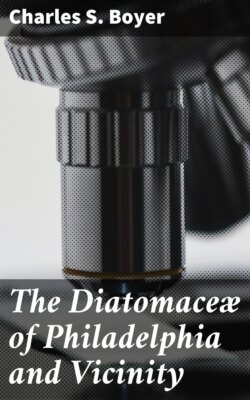Читать книгу The Diatomaceæ of Philadelphia and Vicinity - Charles S. Boyer - Страница 8
На сайте Литреса книга снята с продажи.
Cell Division
ОглавлениеTable of Contents
The growth of diatoms follows the usual method of cell division as described by Sachs (Text Book of Botany, 2nd ed., p. 16): "The nucleus of a cell which is about to divide becomes broader, assuming the form of a biconcave lens, and its nucleolus breaks up into irregular granules which together with its other granular contents begin to form a nuclear disc in the equatorial plane. A delicate striation is now apparent in what is becoming the long axis of the nucleus, at right angles to the nuclear disc, and the characteristic nuclear spindle is gradually produced. The nuclear disc splits into two halves lying side by side, each of which travels to the corresponding pole of the nucleus; thus two nuclei are constituted which are connected by fibrillæ."
The cell-wall and the chromatophore bands divide, each nucleus passes to the centre, and two new cells are formed. In the meantime, to permit of this division, the two siliceous valves separate, the girdle bands slipping over each other, and opposite the larger or enclosing valve a new valve is formed, the girdle band of which is seen later within the girdle of the mother valve. Opposite the smaller valve of the original cell and adjoining the new valve, another valve is formed which also produces a girdle within the girdle of the smaller valve. As a result of division we have, therefore, the valves of the original, or mother cell, the two new valves and four girdle bands. (Pl. 40, Figs. 18 and 19.)
In the process of division, the continual formation of new valves, enclosed in the older girdle bands, will naturally cause a reduction in the size of the frustule. While this reduction, owing to the elasticity of the girdle, does not always occur, I believe, yet, in most cases, the diameter is so reduced that a rejuvenescence of growth is required. This is caused by the production of auxospores which may appear without conjugation. In this process, the beginning of which, in certain species, may be noticed by the increase in the size of the girdle as in reduplication, the two valves separate and within is formed a more or less spherical mass about twice the size of the original frustule and which forms on its circumference two large and often shapeless valves. These valves form others which assume the appearance of the original valves, but larger, and proceed to grow in the usual way. The reduction in size of the frustule seldom proceeds further than about half the size of the type form, so that, as a general rule, it may be stated that diatoms are not often smaller than half the larger size.
